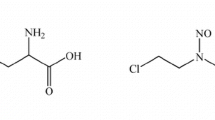Abstract
A method for the quantitative determination of lobenzarit (2-[(2-carboxyphenyl)amino]-4-chlorobenzoic acid) in dog plasma by high-performance liquid chromatography with UV detection (308 nm) is described. Plasma samples (200 µl) were treated with acetonitrile and centrifuged, and the clear supernatant injected onto a reversed-phase phenyl column. The method achieved a limit of quantitation of 0.5 µg/ml in plasma, and the response was linear to 100 µg/ml. Comparing a solution and a tablet formulation given to beagle dogs, the assay demonstrated that the solution formulation was slightly more bioavailable and yielded a more variable absorption rate. The elimination of lobenzarit from plasma followed a biexponential time course, with an apparent terminal disposition half-life of between 5.8 and 10.7 hr.
Similar content being viewed by others
REFERENCES
K. Ohuchi, M. Watanabe, Y. Fukui, N. Hirasawa, T. Ozeki, and S. Tsurufuji. The effect of diphenylamine derivatives on arachidonic acid metabolism in rat peritoneal macrophages. Prostaglandins Leukotrines Med. 28:15–23 (1987).
T. Takeuchi, J. Koide, O. Hosono, M. Takano, and T. Abe. CCA, N-(2-carboxyphenyl)-4-chloroanthranilic acid disodium salt, a newly developed immunomodulating drug, suppresses T-cell activation by acting on macrophages. Inflammation 13:125–135 (1989).
F. Imai, T. Suzuki, T. Ishibashi, T. Katagiri, and K. Hara. Effect of lobenzarit disodium (CCA) on B cell differentiation to antibody secreting cells. Arerugi 38:36–40 (1989).
T. Komori, T. Nakano, and Y. Ohsugi. Alleviation of depressed immunity caused by restraint-stress, by the immunomodulator, lobenzarit disodium (disodium 4-chloro-2,2′-iminodibenzoate). Int. J. Immunopharmacol. 9:433–441 (1987).
M. Fujimoto, I. Sugawara, M. Kimoto, S. Ishizaka, and T. Isujii. Immunopharmacological study of CCA (Lobenzarit disodium), an anti-arthritis agent. I. Abrogation of IL-1 secretion by LPS-stimulated human monocytes and induction of gammainterferon production with CCA. Int. J. Immunopharmacol. 8:323–328 (1986).
I. Yamamoto, H. Ohmori, and M. Sasano. Effect of N-(2-carboxyphenyl)-4-chloroanthranilic acid disodium salt (CCA) on the induction of helper and suppressor T cells in vitro and in vivo. Jpn. J. Pharmacol. 33:859–866 (1983).
Y. Ohsugi, T. Nakano, and S. Hata. A novel antiarthritic agent, CCA (lobenzarit disodium), and the role of thymus-derived lymphocytes in the inhibition of rat adjuvant arthritis. Immunopharmacology 6:15–21 (1983).
Y. Shiokawa, Y. Horiuchi, Y. Mizushima, T. Kageyama, K. Shichikawa, T. Ofuji, M. Honma, H. Yoshizawa, C. Abe, and N. Ogawa. A multicenter double-blind controlled study of lobenzarit, a novel immunomodulator, in rheumatoid arthritis. J. Rheumatol. 11:615–623 (1984).
E. Abignente and P. D. Caprariis. In K. Florey (ed.), Analytical Profiles of Drug Substances, Academic Press, New York, 1982, pp. 313–346.
L. Cotellessa, R. Riva, P. Salva, F. Marcucci, and E. Mussini. Quantitative determination of flufenamic acid in rat plasma and uterus by gas chromatography. J. Chromatogr. 192:441–445 (1980).
L. J. Dusci and L. P. Hackett. Gas-liquid chromatographic determination of mefenamic acid in human serum. J. Chromatogr. 161:340–342 (1978).
H. Roseboom and A. Hulshoff. Rapid and simple clean-up and derivatization procedure for the gc determination of acidic drugs in plasma. J. Chromatogr. 173:65–74 (1979).
M. E. Sharp. A rapid screening procedure for acidic and neutral drugs in blood by high resolution gas chromatography. J. Anal. Toxicol. 11:8–11 (1987).
O. Kubo, K. Nishide, and N. Kiriyama. Quantitative determination of flufenamic acid and its major metabolites in plasma by high performance liquid chromatography. J. Chromatogr. 174:254–257 (1979).
C. K. Lin, C. S. Lee, and J. H. Perrin. Determination of two fenamates in plasma by high-performance liquid chromatography. J. Pharm. Sci. 69:95–97 (1980).
G. G. Skellern and E. G. Salole. A high speed liquid chromatographic analysis of indomethacin in plasma. J. Chromatogr. 114:483–485 (1975).
I. M. Johansson and M. L. Eklund. Liquid chromatographic determination of meclofenamic acid in equine plasma. J. Liq. Chromatogr. 7:1609–1626 (1984).
H. J. Battista, G. Wehinger, and R. Henn. Separation and identification of nonsteroidal antirheumatic drugs containing a free carboxyl function using high-performance liquid chromatography. J. Chromatogr. 345:77–89 (1985).
G. Dannhardt, S. Laufer, and M. Lehr. HPLC determination of etofenamate and flufenamic acid in biological material. Clin. Chem. 34:2580–2581 (1988).
C. I. Omile, I. R. Tebbett, and B. Danesh. Determination of ten anti-inflammatory drugs in serum by isocratic liquid chromatography. Chromatographia 22:187–188 (1986).
O. Ishidaka, T. Shinohara, T. Tanaka, and A. Momose. Determination of mefenamic acid in horse plasma by high performance liquid chromatography. Bunseki Kagaku. 35:332–334 (1986).
M. Schulz, and A. Schmoldt. Determination of nonsteroidal antiinflammatory drugs in human plasma by high performance liquid chromatography. PZ Wiss. 2:41–44 (1989).
J. Sato, E. Owada, K. Ito, Y. Niida, A. Wakamatsu, and M. Umetsu. Simple, rapid and sensitive reversed-phase high-performance liquid chromatographic method for the determination of mefenamic acid in plasma. J. Chromatogr. 493:239–243 (1989).
K. Shimada, M. Nakajima, H. Wakabayashi, and S. Yamato. Determination of mefenamic and flufenamic acids in serum by HPLC with electrochemical detection. Bunseki Kagaku 38:632–635 (1989).
K. Ikeda, K. Uekama, M. Otagiri, and M. Hatano. Circular dichroism study on inclusion complexes of b-cyclodextrin with anti-inflammatory fenamates. J. Pharm. Sci. 63:1168–1169 (1974).
Author information
Authors and Affiliations
Rights and permissions
About this article
Cite this article
Schwende, F.J., Turner, S.W. High-Performance Liquid Chromatographic (HPLC) Determination of Lobenzarit in Plasma and Its Application to a Bioavailability Study in Beagle Dogs. Pharm Res 8, 523–526 (1991). https://doi.org/10.1023/A:1015867631797
Issue Date:
DOI: https://doi.org/10.1023/A:1015867631797



